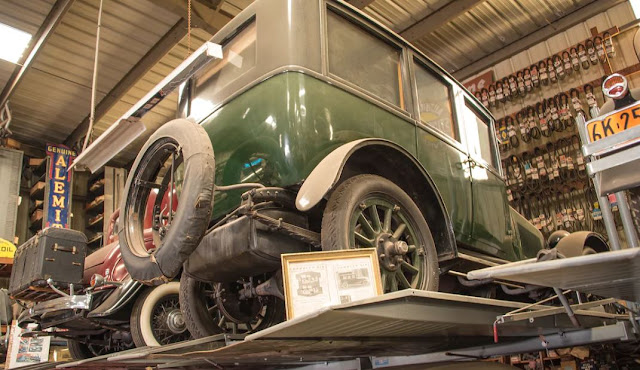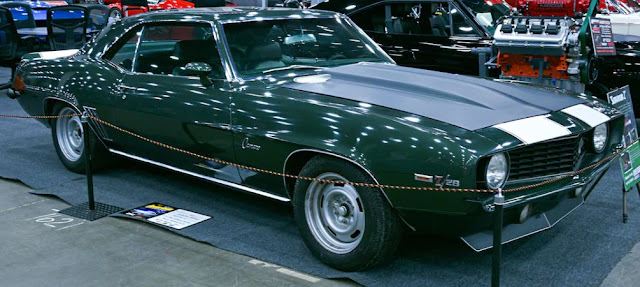in Oregon, rodders started Woodburn Drag Strip with men and machines donated by a pictured USMC unit practicing airstrip construction.
In late 1958, the Multnomah Hot Rod Council (produced the first annual Portland Roadster Show in 1956) bought the old West Woodburn Airport strip from the Northwest Timing Association for about $4,000. Even so, the building of the strip was a joint venture between the two groups.
Considerable work had been done prior to the groups selling "stock" early 1959 to raise funds for the paving of the strip. Each "stock" certificate was sold for $1 and granted the purchaser two free admissions to the forthcoming races.
Initial plans called for it to be a 1/8th-mile strip, paved 60 feet wide by 2000 feet long. It was twelve miles north of Salem. The Multnomah Hot Rod Council and the Northwest Timing Association conducted NHRA-sanctioned races for the first time beginning on June 4, 1961, running gas only, on the Woodburn Dragstrip. About 2,000 spectators turned out to see 75 cars compete.
https://dragstriplist.com/oregon
Dee Wescott was born in Portland Oregon August, 13, 1927. While in grade school the family lost everything in the depression and moved to the Damascus Oregon area where family could help out.
Dee bought his first car in 1939, when he was twelve years old. It was a Model T Ford pickup which, he said, he soon began to modify, rebuilding the motor in his bedroom. A few years later he was racing a Model T roadster through the orchards of Damascus. Dodging trees was a little rough on the cars, so Dee started a backyard repair shop with a homemade wooden hoist, a humble beginning for his future rod-building career.
Dee enlisted in the Navy on graduating high school, while 17. Dee was selected for advanced avionics training and became a radio and radar technician, and served two carrier tours in 1946-1947.
After discharge Dee entered vocational school for both auto mechanics and auto body repair, while working part time for an upholstery shop. In 1953 Dee went into business as “Wescotts Auto Restyling”. The new business specialized in “hot rodding” and “customization” of cars, along with body and fender repair and painting.
By 1953, Dee was involved with the Motor Sports Association which held races at the Jantzen Beach raceway. When a fellow driver was badly burned Dee took on the promoters insisting that they provide and maintain adequate firefighting equipment to prevent further tragedy.
Having proved himself as a leader, Dee was the natural spokesman for the rodders. When the clubs organized the Multnomah Hot Rod Council in 1954, Dee became the first president.
The first order of business was to move the races off of city streets, so the council negotiated for permission to race on idle airstrips until a permanent racing facility could be found. In 1958, the council purchased the Woodburn Drag Strip, and the races became more official.
https://www.hotrod.com/articles/0901rc-dee-wescott-passed-away/
http://oregonhotrod.com/events.htm
The Marines and Sea Bees made airstrips all over the south Pacific... during WW2, I suppose it makes sense that DOD leadership probably felt it was a good idea to keep them adept at doing so after WW2, and keep the equipment in use
https://www.ibiblio.org/hyperwar/USMC/I/USMC-I-VI-4.html
The military used Catalina island for training during World War II. “A lot of the roads, the infrastructure, was built by the Army Corps back in the ’40s"
This spring, a new concrete runway built by Marines will finish upgrades to Catalina island's airport. Why? Why isn't the Wrigley family, who own's 90% of the island through a "land conservancy" aka legal protection from anyone else doing any construction or development, which means they are about the only beneficiary of the airport, and the 4000 residents... and if you're living on the only island off the California coast, you're not less than rich and well off.
Well, rich people get and stay that way by figuring out how to hang onto money, and spend someone else's money. So, when someone heard of the military reserves getting green lit to be used to do construction as a "military readiness and training" through the Defense Department’s “Innovative Readiness Training” program, they went for it, and now the old, asphalt runway on the island some 50 miles west of Camp Pendleton, used only by privately owned, and chartered jets of the very wealthy, will benefit from the discovery of this military loophole.
The airport sees about 7,500 landings annually.
I say loophole, as you're probably aware, you can't get the military involved in being stationed on the border, helping with fighting wild fires, or whatever else the high tech and highly trained soldiers could do easier, faster, and better funded than anything in the law enforcement or national park dept can.
MWSS-373 Marines can patch up damaged runways... The 3,000-foot-long by 75-foot-wide runway will require enough high-quality concrete to cover an area more than five acres in size and four inches deep. Instead of handling heavy bags of quick-setting powder, Marines will work with concrete from trucks hauling loads from one of the island’s concrete plants.
So the Catalina project is far larger in scope than rapid runway repair work Marines typically do and more akin to larger-scale runway repair and airfield construction done by Seabees and “RED HORSE” heavy-construction squadrons with the Air Force and Air National Guard.
Several Seabees with Naval Construction Group 1 and Naval Mobile Construction Battalion 25 from Port Hueneme helped Marines learn the ins-and-outs of working with concrete and rebar, he said. About 120 Marines and some Seabees will work on the project at any given time.
By rotating groups of Marines to Catalina, “we maximize the experience and really take advantage of this opportunity to create a really broad group of Marines who have significant expertise in concrete.”
The Pentagon’s Innovative Readiness Training program started 25 years ago to bolster military readiness while helping local needs. Communities, including remote Native American and Alaska Native villages, request medical, veterinary, cybersecurity, construction or engineering support. Missions often are assigned to reserve units. Some projects are significant, like the long-planned and pending relocation of the Alaskan village of Newtok to higher ground. Others take time. Marine reservists last summer finished a 2,000-foot extension to the Old Harbor airport on Alaska’s Kodiak Island, a project that took six years to complete.
The Catalina Island Conservancy, which owns the airport, (
like I said) tapped IRT in early 2017 to help rebuild the nearly 80-year-old runway. Officials didn’t expect to work with Marines.
“We actually were thinking about the Seabees, because we had heard the Seabees do this type of work,” said Cynthia Fogg, the Conservancy’s government liaison and assistant to the president and board. Referrals took them to Port Hueneme, home to West Coast Seabees, and Camp Pendleton, home of I Marine Expeditionary Force. I MEF and the 3rd Marine Aircraft Wing assigned the Catalina project to MWSS-373 to rebuild the runway, along with input from Naval Construction Group 1, 1st Naval Construction Regiment and Navy Mobile Construction Battalion 25, Fogg said.
The privately run Catalina Airport, nicknamed “Airport-in-the-Sky,” is unusual for its location. It sits at 1,602 feet elevation, at the edge of a cliff. Its Runway 4/22 has a hump in the middle to help slow the speed of Wrigley’s DC-3 airplanes.
Three barges loaded up the squadron’s equipment and supplies in San Pedro, Calif. Several days before Christmas, Marines finished the offload at Cat Harbor and transported the gear 13 miles to the airport. The equipment included graders, compactors, scrapers, 7-ton transport trucks and 84 pallets of meals-ready-to-eat and unitized group rations. The squadron will set up an expeditionary camp at the airport, with large BASE-X tents and a field mess and medical section. The Conservancy is providing an empty hangar and trailers for the Marines to use for maintenance and support. Marines will buy perishable foods locally and tap into the local water supply.
With the first phase completed before Christmas, Marines will arrive by helicopters and start work in early January, Flood said. They’ll do final land surveys, check the grade and compact the ground, and they’ll work in phases to build the forms, lay the rebar and pour the concrete that will daily by trucks.
https://news.usni.org/2019/01/02/marines-flex-expeditionary-construction-skills-rebuilding-airport-sky


















































